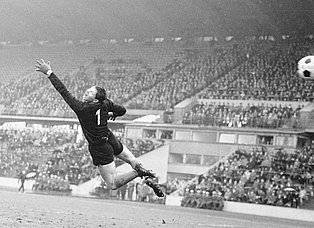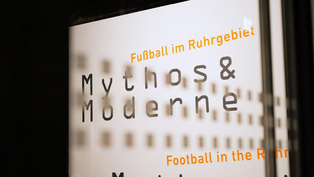Mon–Sun
10am–6pm
Adult: 10 €, Reduced: 7 €,
Children / young people under 18 and
Pupils / students under 25 years: free admission

"Land of 1,000 derbies" and "heart of German football": No other region in Germany is as associated with soccer as the Revier. Here, football is a deeply rooted social and cultural phenomenon, an attitude to life that is reminiscent of England, the motherland of football, in terms of tradition and expression. The Ruhr and Rhine form something like a core region - or, as Franz Beckenbauer put it: "The heart of soccer beats in the Ruhr region".
By activating the video, you accept the Vimeo privacy policy.
To the privacy policy

One year before the kick-off of the 2024 European Football Championship in Germany, the German Football Museum and the Ruhr Museum are jointly presenting the first special photographic exhibition on the entire Ruhr region's football in the spectacular bunker level of the Coal Washing Plant at the Zollverein UNESCO World Heritage Site.
Prof. Heinrich Theodor Grütter, museum director of the Ruhr Museum and board member of the Zollverein Foundation: "Our exhibition presents the past and present of one of the most exciting football regions in Germany with fascinating photographs."
Manuel Neukirchner, Director of the German Football Museum: "Science, culture, technology and innovations are the major drivers and perspective providers for a region that - this is also impressively documented in our photo exhibition - has transformed and redefined itself in recent decades. Football as a source of identity has become a reliable constant. It is there for the people, especially in the Ruhr conurbation with its diverse forms of cultural exchange, with its approximately five million people from 170 nations."
The exhibition is the first special photographic exhibition on the history of Ruhr football. More than 450 classic, as well as never-before-shown football motifs come from the Ruhr Museum's large photo archive, as well as from well-known photographers such as Andreas Gursky and Roland Wirtz, from renowned photo agencies and from the archives of cities and clubs. The two epochs of myth and modernity are each presented and contrasted in eleven themes: Lifestyle, On the pitch, District derbies, Triumphs and Tragedies, Legends and Idols, Places of Action, Stadium Visits, On Ashes, At the sidelines, Solidarity and Commercialization.
Children on meadows with makeshift gates in front of industrial wastelands, fans on their way to the stadium at the Trinkhalle - the interplay between people, landscape and regional landmarks creates a picture in which nostalgia and present-day enthusiasm merge. Against this background, myth and modernity do not form opposites, but rather create a vivid kaleidoscope of football in the Ruhr region with the individual perspective of the viewer. In a side cabinet, the German Football Museum also displays highlight exhibits on the topic from its permanent exhibition, including Helmut Rahn's original jersey from the 1954 World Cup final.
"Football is worked here." Soccer in the Ruhr is the story of a working-class sport. Originally a middle-class, elitist sport, it became a mass event and experience in the Ruhr after the First World War. The coal mines provided places for miners to play soccer on their premises and supported the local clubs. The legendary rise of FC Schalke 04 to become the pre-eminent German soccer team in the 1930s and 1940s subsequently triggered unprecedented soccer enthusiasm from Dortmund to Duisburg. Many players were still working underground at the time. Malocher clubs continued to shape Ruhr soccer after the Second World War. More than a dozen colliery and workers' clubs played in the highest division, the Oberliga West. Championships and cup successes were celebrated in the region; Rot-Weiss Essen and Borussia Dortmund, Schwarz-Weiß Essen and FC Schalke 04 recorded victory after victory. With the mining crisis, sporting decline followed from the 1970s onwards. Even at the two showpiece clubs Dortmund and Schalke, gloom reigned. Nevertheless, the myth of Ruhr soccer with its triumphs and idols endures to this day.
Live and in color: With the live broadcasts of matches in the European professional leagues, professional soccer has probably experienced its most profound change since the 1990s. The new era is also characterized in the Ruhr region primarily by commercialization, which is represented by the three Bundesliga clubs FC Schalke 04, Borussia Dortmund and VfL Bochum. Top-level soccer is experiencing exponential growth. More and more money is flowing into the sport, especially from lucrative television contracts. With other professional clubs such as MSV Duisburg, Rot-Weiss Essen, Rot-Weiß Oberhausen and SGS Essen, the most prominent representative of the increasingly popular women's soccer, the Ruhr region is still the most densely populated soccer region in Germany.
Amateur soccer can hardly keep up with this development, including the expansion of the sports infrastructure. But the small, often legendary clubs continue to shape soccer between the Emscher and Ruhr rivers to this day. At grassroots level, soccer is the number one popular sport. Right on the doorstep, fans can experience soccer up close on soccer fields, in small stadiums and large arenas, or follow the games of professional clubs in the media.
The two main sponsors of the exhibition are the RAG Foundation and the Foundation Fußball & Kultur EURO 2024 gGmbH.
RAG-Foundation
The RAG Foundation, based at the Zollverein UNESCO World Heritage Site, is the main sponsor of the exhibition. "The development of football in the Ruhr region was closely linked to the history of mining," says Bärbel Bergerhoff-Wodopia, a member of the RAG-Foundation's board of directors, explaining the commitment. "The football culture of the Ruhr is an important part of the region's mining heritage, which is why supporting this special exhibition is very close to our hearts."
Foundation Football & Culture EURO 2024 gGmbH
The Foundation Fußball & Kultur EURO 2024 gGmbH is a subsidiary of the DFB Cultural Foundation based in Frankfurt am Main and is funded by the German federal government by resolution of the German Bundestag. Its business purpose is to coordinate the promotion of arts and cultural projects for the supporting program for UEFA EURO 2024 in Germany. The chairwoman of the supervisory board is Claudia Roth, Minister of State for Culture and Media. "The joint initiative of the German Football Museum and the Ruhr Museum in the heart of football Germany convinced us," Roth said. "Football is not just sport in the Ruhr region. Football is passion and connects people, regardless of age and origin. That's why this exhibition is also part of the nationwide cultural program accompanying EURO 2024."
For more than 100 years, soccer has fascinated people and been a reliable source of news and images. Even in the early days, it was documented photographically and on film. With its popularization, the games are photographed more and more intensively, including the background: the stands, spectators, logistics, arrivals and departures, honors, footballers in their private lives - a huge selection of motifs. Today, not only are all professional games broadcast on television; photographers continue to be posted on the sidelines, providing almost real-time coverage: Impressions from the stadiums, pictures of players, goal kicks, cheers, capers, coaching zones. Soccer in the Ruhr region offers an endless world of images.
On display are press photographs as well as photo projects by students of the renowned photographer Otto Steinert, and in individual cases also by internationally renowned photo artists such as Andreas Gursky and Roland Wirtz. The starting point for the selection of images is the Ruhr Museum's photo archive, which now comprises more than four million historical image units. And the cooperation with the regional sports photo agency Firo and other picture agencies also makes it possible to look at the soccer present. In black and white and in color, the two museums are dedicated to the two areas of "myth" and "modernity" of Ruhr area soccer. As a subject of the daily press, soccer was long depicted only in black and white. Color photography appeared sporadically in the 1970s in magazines or advertisements. In the sports press, the color image only prevailed at the end of the 1990s with the new printing presses and finally digital distribution, and has since shaped the modern image of Ruhr area soccer.
The Ruhr region's history is one of the main reasons why it is a soccer region. The region grew with soccer; the former workers' sport was the concomitant of the industrial region's ups and downs and its reinvention as a metropolitan region. It led to great successes and championships as well as to defeats and relegations, and even to the slide of traditional clubs into insignificance. Today, Ruhr soccer is experiencing a certain renaissance. With Borussia Dortmund, Schalke 04, VfL Bochum, MSV Duisburg and Rot-Weiss Essen, five Ruhr clubs play in the various German leagues. And finally, organized soccer in the Ruhr region is celebrating an anniversary rich in tradition: the West German Soccer Association is celebrating its 125th anniversary this year as one of the oldest soccer associations ever.
However, the "land of a thousand derbies" also thrives on its contradictions, rivalries and the challenges it has had to face time and again in the past and present. Industrialization brought economic prosperity but also hard work, immigration required the development of integration processes, the collapse of coal and steel challenged the self-image of the entire region. And in the middle of it all was and still is soccer. As a projection surface, as a place of refuge and longing, as a representative and engine of development, as the most important secondary matter in the world, but mainly as a game in which myth and modernity are reflected.
Upon presentation of a season ticket of a Ruhr club or a ticket of the German Football Museum reduced admission to this special exhibition.
On presentation of a ticket for this special exhibition, 20% discount on single and family tickets for the German Football Museum when purchased at the box office.
1 hour, in German and English
At over 25 stations, the tour via app leads through the fascinating world of soccer in the Ruhr region.
368 pages, with more than 480 illustrations, Klartext Verlag, Essen 2023, €29.95
ISBN 978-3-8375-2597-7
Further information about the exhibition can be found here as PDFs for download:
Share